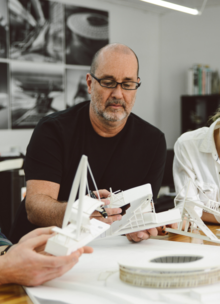This article has multiple issues. Please help improve it or discuss these issues on the talk page. (Learn how and when to remove these messages)
|
Dan Meis | |
|---|---|
 | |
| Born | 1961 (age 62–63) Windsor, Colorado, U.S. |
| Nationality | American |
| Alma mater | |
| Occupation | Architect |
| Awards | American Institute of Architects fellowship |
| Practice | MEIS Architects |
| Projects | |
Dan Meis, FAIA, RIBA[1] (born 1961) is an American architect known for designing sports and entertainment facilities including Staples Center, Safeco Field, Paycor Stadium, Saitama Super Arena, Stadio Della Roma,[2] and Everton FC's new Everton Stadium.
He began his career in Chicago under the mentorship of architect Helmut Jahn and later co-founded the sports and entertainment practice of NBBJ. Meis currently operates his own independent studio, MEIS Architects, established in 2007,[3] with offices in New York City and Los Angeles, California.
His firm has recently formed a partnership with Maria Sharapova to build tennis, fitness, and wellness centers.[4] MEIS is also working with entertainment giant Live Nation to design venue upgrades across a portfolio of outdoor amphitheaters.[5]
His design for AS Roma's Stadio Della Roma includes football's tightly organized seating bowls.[6] The stadium is wrapped in a floating stone "scrim", which is intended to evoke the Colosseum.[7] Currently under construction, the new MEIS designed MLS stadium for FC Cincinnati, located in Cincinnati's West End neighborhood, will have an estimated seating capacity of 26,000 to 26,500.[8]
While at Ellerbe Becket in the 1990s, Meis designed the indoor arena Nynex Arena (now Manchester Arena) in Manchester, England, and led the design competition that won the $750 million Saitama Super Arena in Japan.[9] Meis then left Ellerbe Becket to join NBBJ, establishing NBBJ's sports division with Michael Hallmark and Ron Turner.[10] Meis designed the Staples Center in Los Angeles, the Dodge Theater (now Comerica Theatre) in Phoenix, Miller Park in Milwaukee, Safeco Field in Seattle, Lincoln Financial Field in Philadelphia, and Paul Brown Stadium in Cincinnati, which was the first NFL facility to win an AIA design award.[11]
- ^ "AIArchitect, February 24, 2006 - AIA Elevates 82 to Fellow; 13 to Honorary Fellow". info.aia.org. Retrieved February 21, 2019.
- ^ "Home | Stadio della Roma". stadiodellaroma.com. Archived from the original on November 1, 2019. Retrieved January 18, 2016.
- ^ "Sports, Entertainment and Experience Architecture". MEIS Architects. Retrieved January 18, 2016.
- ^ Giacobbe, Alyssa (November 27, 2018). "Maria Sharapova Built a Business Empire Thanks to Her Winning Team". Entrepreneur. Retrieved February 21, 2019.
- ^ "Summer Refreshments: Live Nation Starts Rolling Out Renovations at Amphitheaters". VenuesNow. June 3, 2019. Retrieved July 22, 2019.
- ^ "Stadio della Roma". www.asroma.com. Archived from the original on February 22, 2019. Retrieved February 21, 2019.
- ^ "Stadium of Rome by Meis Architect". aasarchitecture. June 21, 2015. Retrieved February 21, 2019.
- ^ "FC Cincinnati Unveils Designs For New Soccer-Specific Stadium". www.sportsbusinessdaily.com. October 10, 2018. Retrieved February 21, 2019.
- ^ "Saitama Super Arena". www.spaziomondo.com. Retrieved January 28, 2016.
- ^ "Dan Meis to Head Woods Bagot Sport". Architect Magazine. Retrieved January 28, 2016.
- ^ "AIArchitect, Sept. 3, 2001 - AIACC Recognizes Design Excellence". info.aia.org. Retrieved January 18, 2016.